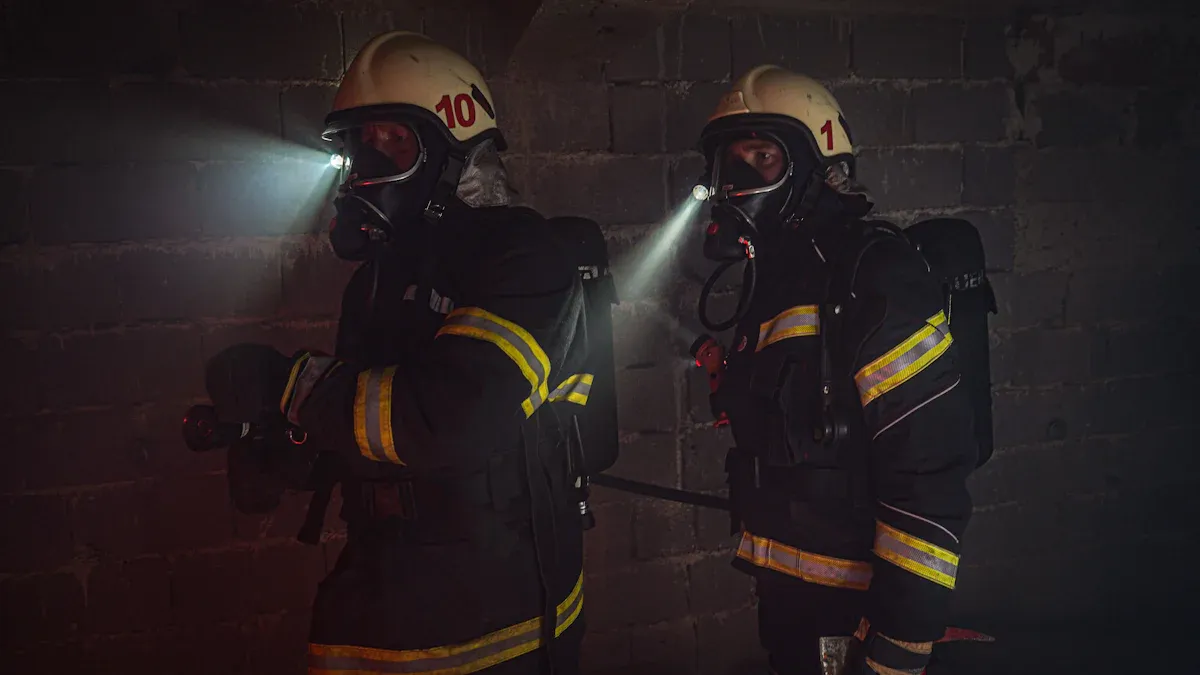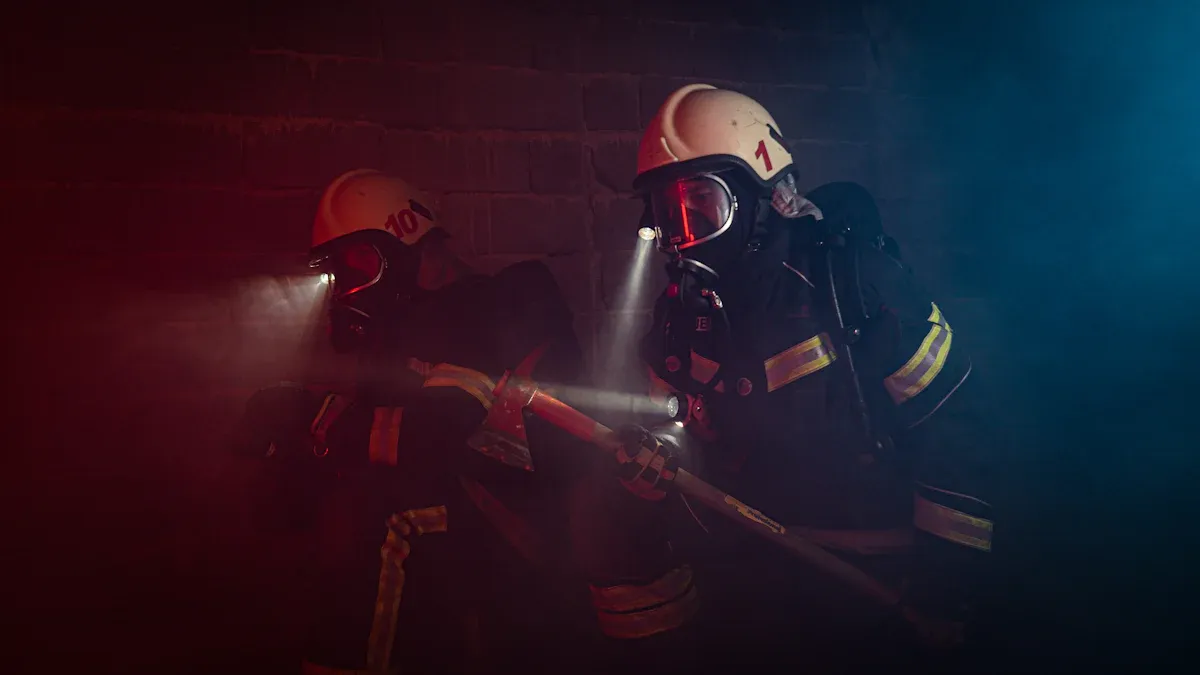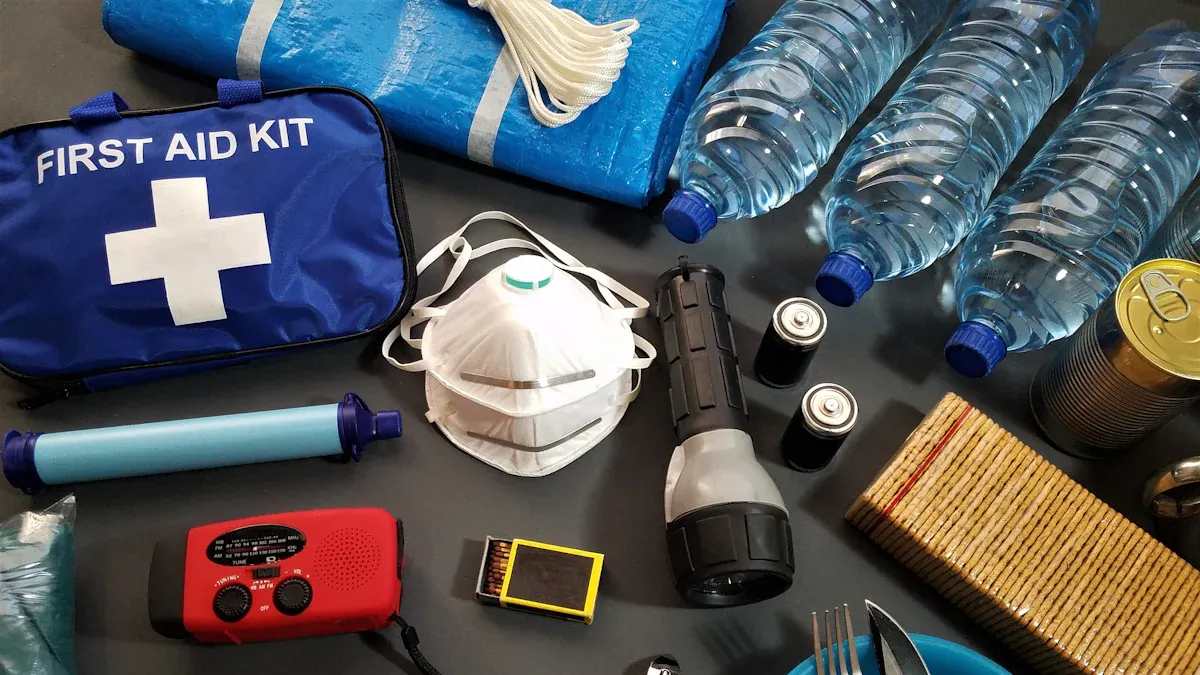Emergency Response Flashlights: The Backbone of Disaster and First-Aid Readiness

You need emergency response tools to stay safe in disasters. Good light helps you move fast and see where to go. It also helps you help others in emergencies. Almost every home in the United States has a battery flashlight in their kit:
94.8% of homes have a working flashlight.
Research shows that good lighting makes people safer and helps them survive.
Study Title | Findings |
|---|---|
Influence of lit emergency signs and illuminated settings on walking speeds in smoky corridors | Good lighting helps people walk faster and leave quicker, even when there is smoke. |
How LED Lights Improve Road Safety for Emergency Vehicles | LED lights turn on right away and help keep people safe by warning drivers fast. |
You should pick strong, self-powered flashlights. You can also buy wholesale bulk flashlights for your kit.
Key Takeaways
Emergency flashlights are very important for safety in disasters. They help you see well. They let you move fast. You can help others who need it.
Pick flashlights that are strong and dependable. Find ones with water resistance. Choose ones with long battery life. Look for flashlights with different brightness levels. These features make them work better.
Keep flashlights easy to reach at home and in kits. Put them in different rooms. Place some near doors for quick use. This helps during power outages or emergencies.
Check your flashlights often and take care of them. Test them every month. Change batteries when needed. This makes sure they work when you need them.
Think about buying many flashlights at once to save money. This way, everyone in your family gets one. It also helps you get ready for emergencies in your community.
Why Emergency Response Flashlights Matter
Safety and Visibility
You need to see well in emergencies. Smoke or darkness can fill a room fast. Rechargeable LED torches shine bright beams. These beams help you spot dangers and move safely. First responders use good lighting to act fast and stay safe. Bright light helps them find people and check what is happening. LED technology gives off white light like daylight. This makes it easier to see things in the dark.
Evidence | Explanation |
|---|---|
First responders need proper lighting to perform tasks well. | Good visibility helps them move and react, not just guess where dangers are. |
Reliable light helps find people and check situations. | Better visibility lowers the chance of accidents, especially in search and rescue. |
LED technology gives off white light like daylight. | This clear light helps responders spot dangers and move safely in tough places. |
You can see that good lighting lowers accidents and keeps people safer in disasters.
Critical Tasks in Darkness
You may have to do important things in the dark. Flashlights help you decide and act quickly. For example, during Hurricane Katrina, the Johnson family used a flashlight to walk through water and call for help. You might need to find a way out or fix a car at night. Flashlights give enough light so you can move fast and stay safe.
Flashlights help you find people and check what is happening.
They help you see dangers, so you have fewer accidents.
In search and rescue, seeing clearly can save lives.
Psychological Reassurance
Good lighting makes you feel better in disasters. Soft light that does not glare helps you feel calm when things are scary. It helps stop panic and confusion after an emergency. When you feel safe, you can think better and help others. A safe place also helps rescue teams work well.
Soft light helps you feel calm.
It stops panic and confusion.
A safe place helps rescue teams do their job.
Flashlights in Disaster and Emergency Scenarios

Power Outages
Disasters like tornadoes or storms can cause power outages. Strong winds or accidents often make the lights go out. Sometimes, you might not have electricity for a long time. If you use medical equipment, this can be risky. Flashlights help you stay safe when it is dark. Candles and oil lamps are not safe because they can start fires. LED flashlights give bright light and use less power. Hand-cranked flashlights work without batteries, so you do not worry about running out. Keep flashlights in different rooms so you can find them fast. Flashlights shine a strong beam, so you can leave your house or walk in dark halls more easily.
Tornadoes and storms often cause power outages.
Flashlights are safer than candles and help stop fires.
LED and hand-cranked flashlights are good for emergencies.
Put flashlights in many rooms so you can grab them fast.
Tip: Check your flashlight batteries often and replace them so they work when you need them.
Natural Disasters
Tornadoes, hurricanes, and earthquakes can happen suddenly. You may have to leave your home during a tornado or after a big storm. Flashlights help you see in the dark and move safely. You can use them to ask for help if you are lost or trapped. During Hurricane Sandy, families used flashlights to walk through flooded streets and broken buildings. Pick a flashlight that lasts a long time, does not break in water, and has different settings. These things help you stay calm and know where you are when things are scary. Flashlights also help you fix things or give first aid if the power is out.
Flashlights help you leave safely during tornadoes and other disasters.
Use them to ask for help or lead others to safety.
Pick strong flashlights with long battery life for disasters.
First-Aid and Rescue
Emergency flashlights are very important for first aid and rescue. You need good light to help people who are hurt in a disaster. In a mine collapse, rescue teams used special flashlights that do not cause explosions. These flashlights keep rescuers and victims safe. Firefighters go to many industrial fires each year, so they need safe and bright lights. Medical workers use flashlights to look at wounds and help people when it is dark. You can use a flashlight to find supplies, read directions, or help others get to safety in an emergency.
Note: Intrinsically safe flashlights are made for dangerous places and are very important for first aid and rescue teams.
Integrating Flashlights into Emergency Kits

Kit Essentials
It is important to have a good emergency kit. Flashlights are needed in every survival kit and first aid kit. You should put more than one flashlight in your kits. This helps you get ready for tornadoes, bad weather, or if you must leave home. Pick different flashlights for different jobs. Rechargeable flashlights are good for daily use. Hand-crank flashlights help if you lose power. Tactical flashlights are very bright and help you find things fast. Keychain flashlights are small and easy to carry in your go-bag.
Flashlight Type | Pros | Cons | Use Case |
|---|---|---|---|
Eco-friendly, often USB-C charging | Require recharging; not ideal if no power access | Daily carry, urban emergency kits | |
Hand-Crank Flashlights | No batteries required | Low brightness, not suitable for extended use | Last-resort or backup lighting |
Tactical Flashlights | Bright, durable, with long throw distance | Heavier and pricier | Outdoor search, self-defense scenarios |
Keychain Flashlights | Ultra-compact, always accessible | Very low brightness, limited runtime | Minor tasks or backup in every kit |
You should also look at your emergency supplies list. Make sure you have food and first aid supplies too.
Placement and Accessibility
Put flashlights where you can grab them fast. Place one in each room, like bedrooms and kitchens. Keep one near doors and exits. Store a flashlight in your survival kit and go-bag. Put one in your first aid kit too. If you get a tornado warning, you can grab a flashlight and leave quickly. Keep a flashlight in your car and shelter-in-place kit. This helps you find things or help others in a disaster. Make sure everyone knows where the flashlights are.
Tip: Put glow-in-the-dark tape on flashlights so you can find them in the dark.
Maintenance Tips
You need to keep your flashlights ready to use. Follow these steps to make sure they work in an emergency:
Test each flashlight every month for 30 seconds. Test them once a year for 90 minutes.
Ask a professional to check your flashlights to keep them working well.
Write down each test and check in a notebook.
Fix any problems right away so your flashlights do not break.
Learn about new rules and tips for emergency kits.
Check the batteries and change them when needed. Always keep extra batteries with your food and first aid supplies. This keeps your kits ready for anything.
Key Features of Emergency Response Flashlights
Durability and Water Resistance
Flashlights must work in tough weather and disasters. You need them to last through drops and bumps. Strong flashlights use special materials like polymer resin or aluminum. These materials do not rust or break easily. Some flashlights have waterproof ratings like IP67 or IP66. This means they can handle dust, rain, or even water. If you drop your flashlight in water, it will still work. You can trust these lights in storms or emergencies.
Feature | Description |
|---|---|
Material | High-strength, non-conductive polymer resin |
Waterproof Rating | IP67 dust-tight & waterproof (1 m for 30 min) |
Impact Resistance | 2 m impact resistance tested |
Material | Corrosion-free materials |
Waterproof Rating | IP66 rating |
Durability | Withstands harsh conditions |
Material | Aircraft-grade aluminum |
Water Resistance | Tough, water-resistant materials |
Impact Resistance | Can withstand being dropped or bumped around |
Tip: Pick gear with strong materials and high waterproof ratings for your emergency kit.
Battery Life and Power Options
Flashlights need to last a long time in emergencies. Some flashlights can charge other devices too. Long battery life means your light will not die fast. You can pick flashlights with regular batteries, rechargeable ones, or hand-crank power. Some models have bright lights and extra features like magnets or tripods.
Model | Brightness (LM) | Battery Life | Power Options | Waterproof | Additional Features |
|---|---|---|---|---|---|
HYKOONT LYD001 | 5000 | Long | None | Yes | Magnetic base, adjustable color temperature |
Hykoont MX5085 | 8000 | Not specified | Built-in power bank | Yes | Tripod-compatible, multiple lighting modes |
Hykoont LS018 | Lower than others | Not specified | None | No | Compact, multi-function modes (strobe/SOS) |
Long-lasting batteries help you stay ready.
Bright lights help you see better in danger.
Strong flashlights can be used many times.
Brightness and Modes
Bright flashlights help you see and stay safe. You should get a flashlight with at least 100 lumens. For searching outside, use one with over 1000 lumens. Many flashlights have different modes like SOS or strobe. These modes help you call for help or change the light for different jobs.
At least 100 lumens is good for emergencies.
Over 1000 lumens is best for searching outside.
SOS and strobe modes make your flashlight more helpful.
Note: Use SOS and strobe modes to signal for help if you need it.
Portability
You need flashlights that are easy to carry. Small and light flashlights fit in your bag or car. You can keep them in many places so you always have one. Some flashlights let you use them with one hand. This helps when you are in a hurry or scared. You can store them in your glove box or emergency bag.
Small flashlights are easy to carry.
Light designs help you move fast.
One-handed flashlights are simple to use.
Self-Powered and Rechargeable Options
Think about how you will power your flashlight. Rechargeable flashlights cost more at first but save money later. They are better for the environment because you do not throw away batteries. You need power to charge them. Flashlights with disposable batteries are always ready to use. They last a long time on the shelf. These are good if you cannot recharge during a disaster.
Feature | Rechargeable Flashlights | Disposable Battery Flashlights |
|---|---|---|
Cost-effectiveness | Higher upfront cost but saves money over time | Lower initial cost but requires constant replacements |
Environmental impact | More eco-friendly, reduces waste from disposable batteries | Contributes to waste, as batteries are not reusable |
Convenience | Requires access to power for recharging | Always ready to use, no charging needed |
Performance in emergencies | May not be practical if power source is unavailable | Long shelf life, reliable for emergencies |
Tip: Put both rechargeable and disposable battery flashlights in your kit to be ready for anything.
Comparing Emergency Flashlight Types
Standard Battery-Powered
Standard battery-powered flashlights use disposable batteries. You can find them in most stores. These flashlights work right away when you put in new batteries. You do not need to wait for charging. Many people choose them because they cost less at first. You can keep extra batteries in your kit for quick changes.
However, these flashlights lose brightness as the batteries run out. You may need to replace batteries often, especially if you use the light for a long time. Over time, the cost of buying new batteries adds up. Used batteries also create more trash.
Factor | Rechargeable Flashlights | Battery-Powered Flashlights |
|---|---|---|
Reliability | Stays bright, lasts long, breaks less often | Starts bright, but gets dim as batteries run out |
Cost | Costs more at first, saves money later, better for earth | Cheaper at first, costs more later, makes more trash |
Rechargeable Models
Rechargeable flashlights use built-in batteries. You charge them with a USB cable or wall plug. These flashlights keep their brightness for a long time. You do not need to buy new batteries. Most models charge in about 2.5 hours. On low mode, some can last up to 12 hours. Eco mode can keep the light on for up to 23 days.
You pay more at first for a rechargeable flashlight. Over time, you save money because you do not buy batteries. These flashlights are better for the environment. You need to remember to charge them before an emergency.
Charging time: about 2.5 hours.
Battery lasts up to 12 hours on low mode.
Eco mode can run for 23 days.
Hand-Crank and Solar
Hand-crank and solar flashlights do not need batteries or plugs. You turn a crank or use sunlight to power them. These flashlights work well when you cannot find batteries or power. They are great for long-term use or when you run out of other options. Hand-crank models may not be as bright, but you can always make them work.
Tip: Keep a hand-crank or solar flashlight in your kit for backup.
Professional Quality vs. Budget Options
Professional flashlights use strong materials and have more features. They last longer and work better in tough conditions. You may pay more, but you get better performance. Budget flashlights cost less and are easy to find. They may not last as long or shine as bright. Choose the type that fits your needs and budget. For emergency kits, mix both types for the best results.
Choosing the Right Flashlight for Disaster Readiness
Assessing Your Needs
You need to think about your situation before you pick a flashlight. Every family and location is different. Some people live in areas with hurricanes or tornadoes. Others may face earthquakes or wildfires. You should ask yourself a few questions:
What types of disasters happen where you live?
How many people are in your home?
Do you have children, elderly family members, or pets?
Will you need to travel at night or stay in one place?
Do you need a flashlight for first-aid or rescue tasks?
You should also think about how long you might need light. Some emergencies last a few hours. Others can last days. If you live in a place with long power outages, you need a flashlight with a long battery life or a self-powered option. You should keep a flashlight in your car, your emergency kit, and your go-bag. This helps you stay ready for any situation.
Tip: Make a checklist of your needs. This helps you choose the right flashlight for your emergency preparedness plan.
Balancing Features and Cost
You will see many flashlights with different features and prices. Some have extra modes like SOS or strobe. Others have strong cases or water resistance. You do not need the most expensive model to stay safe. You should look for a balance between what you need and what you can spend.
Here is a table to help you compare features and cost:
Feature | Basic Model | Mid-Range Model | High-End Model |
|---|---|---|---|
Brightness | 100 lumens | 300-1000 lumens | 1000+ lumens |
Battery Type | AA/AAA | Rechargeable | Rechargeable/Hand-crank/Solar |
Water Resistance | No | Yes | Yes |
Durability | Standard | Improved | Professional |
Price Range | $5-$15 | $20-$50 | $60+ |
You should decide which features matter most for your emergency preparedness. If you need a flashlight for outdoor use, pick one with high brightness and water resistance. If you want a backup for your kit, a basic model may work. You can save money by buying in bulk for your family or group.
Remember: The best flashlight is the one you can trust when you need it most.
Reading Reviews
You should always read reviews before you buy a flashlight. Reviews from other users can tell you if a flashlight works well in real emergencies. Look for comments about battery life, brightness, and durability. Some reviews may mention if the flashlight survived drops or water. You can find reviews on store websites, emergency preparedness forums, and video channels.
Check for reviews that mention real-life use during disasters.
Look for feedback about how easy the flashlight is to use.
Pay attention to any problems with charging or battery life.
Note: Reviews help you avoid flashlights that break or fail when you need them most.
You can also ask friends or family about their favorite flashlights. People who have used their lights in emergencies can give you the best advice. This helps you make a smart choice for your preparedness plan.
Wholesale Bulk Flashlights for Emergency Preparedness
Benefits of Buying in Bulk
You can save money if you buy many flashlights at once. Stores give discounts when you buy a lot together. You get more flashlights for less money. This helps you use your money wisely and get ready for emergencies. You can make sure everyone in your family has a flashlight. Schools, offices, and community centers need many flashlights to keep people safe. Buying wholesale bulk flashlights means you have enough for all.
You also feel calm knowing you have enough supplies. You do not have to worry about running out of flashlights in a storm or blackout. You can keep extra flashlights in different places. This makes it easy to find one when you need it.
Tip: Always check if the flashlights are good quality before you buy wholesale bulk flashlights. Make sure they work well and last a long time.
Best Uses for Bulk Flashlights
There are many ways to use wholesale bulk flashlights. You can put them in emergency kits at home, work, or school. You can give flashlights to neighbors or friends who need help. Many groups use bulk flashlights to help during disasters. Fire departments and rescue teams need lots of flashlights for their jobs. You can also use them at big events or safety drills.
Here is a table that shows how you can use wholesale bulk flashlights:
Use Case | Why It Matters |
|---|---|
Home emergency kits | Every person gets a flashlight |
School safety supplies | Teachers and students stay safe |
Disaster relief groups | Quick response during emergencies |
Extra lighting for large gatherings | |
Workplace safety kits | Employees can find exits in darkness |
You can keep extra flashlights with your other supplies. This helps you be ready for any emergency.
You are important for your family’s safety. Emergency response flashlights help you see in the dark. They let you move quickly and stay calm when things are hard. Put a few strong, self-powered flashlights in your emergency kits. Check your supplies often and get better gear if you need it. Start getting ready now so you can handle any emergency.
FAQ
What type of flashlight should you keep in your emergency kit?
You should keep both a rechargeable flashlight and a hand-crank or battery-powered flashlight. This gives you options if you lose power or cannot recharge. Pick models that are durable and water-resistant for the best results.
How often should you check your emergency flashlights?
You should test your flashlights once a month. Turn them on for at least 30 seconds. Replace batteries if the light is dim. Keep a note of each check in your emergency plan.
Can you use your phone as an emergency flashlight?
You can use your phone’s flashlight in an emergency. However, your phone battery may run out quickly. Always keep a real flashlight in your kit. This keeps your phone charged for calls or messages.
What does “lumens” mean on a flashlight?
Lumens measure how bright a flashlight is. A higher number means a brighter light. For most emergencies, you need at least 100 lumens. For outdoor searches, pick a flashlight with over 1000 lumens.
How do you store extra batteries safely?
Store extra batteries in a cool, dry place. Keep them in their original packaging or a battery case. Do not mix old and new batteries. This helps prevent leaks and keeps your flashlights ready.
See Also
Hand-Cranked Flashlights: Essential Versatile Tools for Emergencies
A Homeowner's Guide to Selecting the Ideal Emergency Flashlight
Why Rechargeable Flashlights Are Crucial for Public Safety
Essential LED Flashlights for Home Use: A Convenient Choice
Hunting Flashlights: Vital Gear for Outdoor Adventure Lovers
